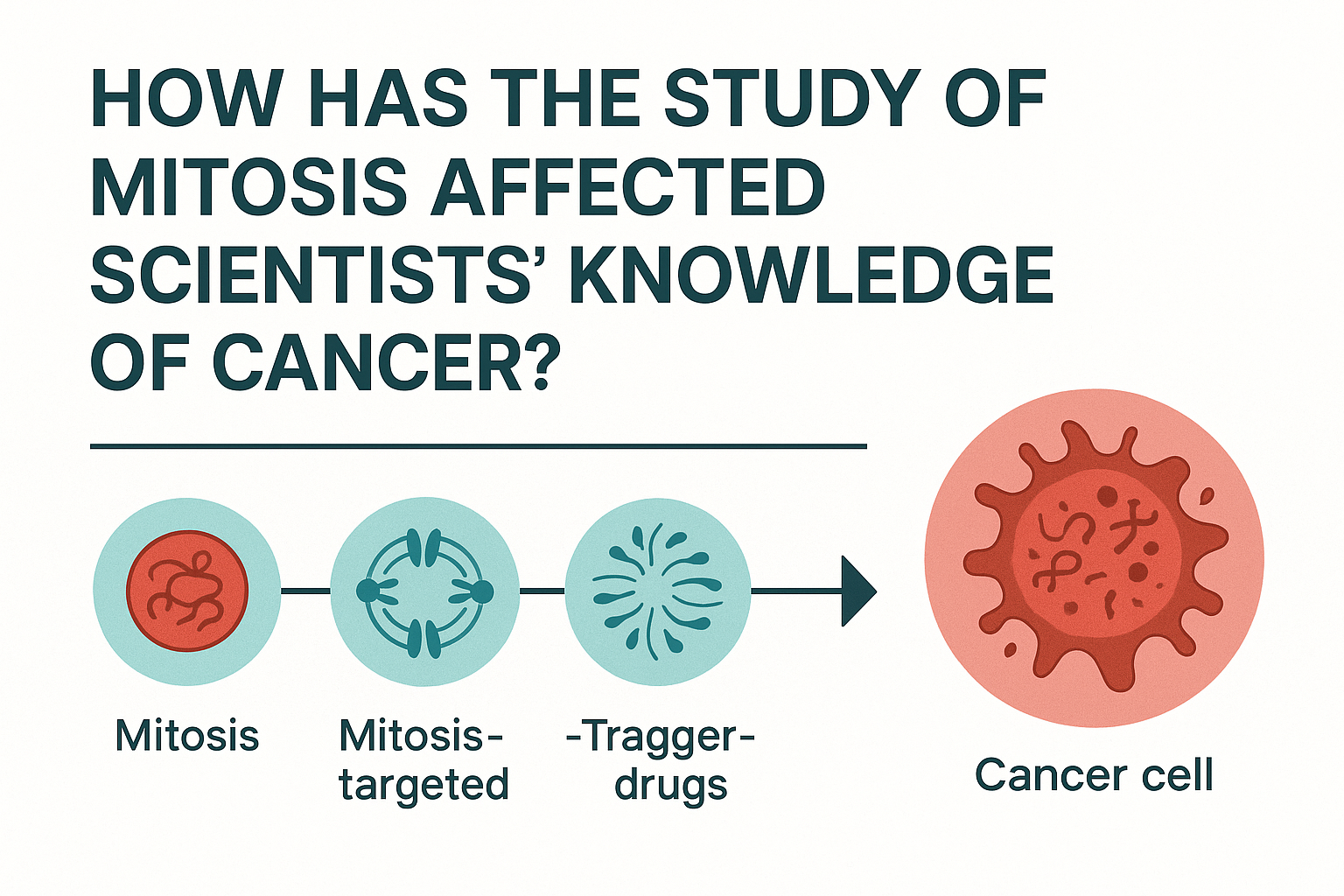
How Has the Study of Mitosis Affected Scientists’ Knowledge of Cancer?
Quick Answer: The study of mitosis has significantly deepened scientists’ understanding of cancer by revealing how errors in cell division can lead to uncontrolled cell growth—a hallmark of cancer. By examining how normal cells divide and identifying what goes wrong during mitosis (e.g., mutations in regulatory genes, malfunctioning checkpoints, or chromosomal missegregation), researchers have been able to uncover the molecular mechanisms behind tumor formation. This knowledge has paved the way for targeted cancer therapies, early detection methods, and precision medicine—making mitosis a cornerstone in modern cancer research and treatment strategies.
The study of mitosis has revolutionized scientists' understanding of cancer by revealing how errors in cell division contribute to uncontrolled cell growth. Mitosis research has helped scientists identify genetic mutations, develop targeted therapies, and create early diagnostic tools that detect cancer based on abnormal mitotic activity.
Understanding Mitosis – The Foundation of Life and Disease
Mitosis is a vital biological process through which cells divide to create two identical daughter cells. This process is central to growth, development, and repair. But when mitosis goes wrong—when it’s unchecked or defective—it can lead to serious conditions, including cancer.
Why This Matters
Cancer is essentially mitosis gone rogue. Normal cells follow rules: they divide when needed and stop when the job is done. Cancer cells, on the other hand, keep dividing—even when they shouldn’t.
Classroom Example
Ms. Patel, a 10th-grade biology teacher, explains mitosis using colored beads to represent chromosomes. Students pair and separate them, mimicking metaphase and anaphase. She then introduces mutated beads to show how incorrect chromosomal separation could lead to tumor formation.
Key Takeaway
Understanding mitosis means understanding cancer at its root cause. The better we understand cell division, the more targeted and effective our treatments can be.

Reflection Question
- Why is it important for cells to divide only when necessary?
How Mitosis Errors Lead to Cancer – A Scientific Perspective
Scientists discovered that cancerous tumors often result from mutations in genes that regulate mitosis. These include oncogenes and tumor suppressor genes like p53.
Real Study Reference
A 2009 study published in Nature linked mutations in spindle assembly checkpoint proteins (like MAD2) with increased cancer risk. When checkpoints fail, damaged cells divide anyway.
Step-by-Step Activity
- Label each mitotic phase with paper cut-outs.
- Simulate a checkpoint failure in metaphase.
- Discuss what would happen if this error was not corrected.
Sample Dialogue
Teacher: “What if this cell with misaligned chromosomes divides anyway?”
Student: “It might pass on the wrong DNA and create abnormal cells.”
Teacher: “Exactly—and that’s how tumors can form.”
Gene Mutations Linked to Mitosis and Related Cancer Types
| Gene | Role in Mitosis | Cancer Type |
|---|---|---|
| p53 | DNA repair checkpoint | Breast, colon |
| MAD2 | Spindle checkpoint | Leukemia |
| RB1 | Cell cycle regulator | Retinoblastoma |
Reflection Question
- How could understanding specific gene mutations improve cancer treatments?
From Bench to Bedside – Targeted Cancer Therapies Inspired by Mitosis
Once scientists understood that cancer is driven by abnormal mitosis, the next step was using that knowledge to create targeted treatments.
Example: Taxol and Vincristine
Drugs like Taxol work by stabilizing microtubules, preventing cancer cells from completing mitosis. This “arrest” halts tumor growth and is the basis for many chemotherapy drugs today.
Classroom Example
In a high school lab, students observe onion root tip slides under a microscope. In treated samples (with simulated Taxol), mitosis is arrested in metaphase. In untreated samples, all stages are visible.
Sample Dialogue
Student: “Why are all the cells stuck in metaphase?”
Teacher: “The drug is stopping the spindle fibers from pulling chromosomes apart.”

Call to Action
Encourage students to research current FDA-approved cancer drugs that target mitotic proteins.
Reflection Question
- How does disrupting mitosis help fight cancer?
Early Detection – Mitosis as a Diagnostic Tool
Mitosis isn’t just useful for treatment—it helps with early detection too. High mitotic activity in biopsied cells is often a sign of cancer.
Example in Practice
Pathologists use a “mitotic index” to measure how many cells in a tumor are actively dividing. A high index often means aggressive cancer that needs urgent treatment.
Classroom Activity
Use sample biopsy images (simulated) to count mitotic figures under a microscope. Ask students to categorize samples as benign, borderline, or malignant based on mitotic activity.
Study Reference
A 2017 report in The Journal of Pathology found that mitotic index strongly correlates with tumor grade in breast and colon cancers.
Cancer Types and Their Average Mitotic Index at Diagnosis
| Cancer Type | Low Grade Mitotic Index | High Grade Index |
|---|---|---|
| Breast | <5 mitoses/10 HPF | >20 mitoses/10 HPF |
| Colon | <3 | >15 |
Reflection Question
- Why might a high mitotic index indicate a more dangerous cancer?
Genetic Engineering and Cancer Research – Using Mitosis as a Guide
CRISPR and gene-editing tools allow scientists to manipulate mitosis-related genes and observe cancer formation in controlled environments.
Real Research Example
In 2022, researchers at Stanford edited the BUB1 gene in mice, leading to chromosomal instability and rapid tumor formation—proving the gene’s role in regulating mitosis.
Classroom Example
Have students role-play as researchers. Assign each group a gene (e.g., p53, RB1, BUB1). Ask them to hypothesize what would happen if that gene were silenced during mitosis.
Dialogue Example
Student: “If we delete BUB1, we might see unequal chromosome numbers in daughter cells.”
Teacher: “Great prediction—that’s exactly what scientists observed.”

Call to Action
Introduce students to tools like CRISPR and encourage exploration of bioethics in gene editing.
Reflection Question
- What are the risks of manipulating genes that regulate mitosis?
Section 6: Cancer Cell Behavior vs. Normal Cell Mitosis – A Comparison
Cancer cells behave very differently in mitosis. They:
- Divide rapidly
- Don’t respond to contact inhibition
- Often have abnormal spindle formations
Activity
Using clay, students can build 3D models of normal vs. cancerous cells in mitosis, identifying key differences in spindle orientation, chromosome count, and nuclear size.
Sample Dialogue
Teacher: “Why do you think cancer cells ignore signals to stop dividing?”
Student: “Maybe they’ve lost the ability to sense their surroundings.”
Teacher: “Exactly! That’s a breakdown in regulatory mechanisms.”
Normal vs. Cancer Cell Mitosis Features
| Feature | Normal Cell | Cancer Cell |
|---|---|---|
| Division Rate | Controlled | Uncontrolled |
| Spindle Formation | Organized | Abnormal |
| Cell Cycle Checkpoints | Active | Often bypassed |
Reflection Question
- What’s one key difference you saw between healthy and cancerous cell mitosis?
Bringing It All Together – The Future of Cancer Treatment Through Mitosis Research
With advances in AI, personalized medicine, and molecular imaging, scientists now tailor cancer treatment plans based on mitotic activity and genetic profiles.
Emerging Therapies
- Mitosis-specific kinase inhibitors (e.g., Aurora kinase inhibitors)
- Biomarkers for early detection based on cell division proteins
Real-World Example
The MITO project (Mitosis Inhibitors in Oncology) is currently trialing next-gen drugs that only affect dividing cancer cells, sparing healthy tissues.
Classroom Project Idea
Assign a group project: “Design a hypothetical cancer drug that targets a specific phase of mitosis.” Students present the phase, mechanism, and side effects.

Final Call to Action
Encourage students to explore careers in molecular biology, oncology, or biomedical research. Mitosis is just the beginning of unlocking cancer’s secrets.
Reflection Question
- How might you contribute to cancer research using knowledge of mitosis?
FAQs
How has the study of mitosis affected scientific knowledge of cancer?
It has provided insight into how uncontrolled cell division leads to tumors, helping scientists identify key genetic mutations and develop targeted treatments.
How was the study of mitosis affected scientists' knowledge of cancer Brainly?
On platforms like Brainly, students learn that mitosis research shows cancer arises from cell cycle misregulation, helping scientists develop therapies like chemotherapy that target rapidly dividing cells.
How does mitosis affect cancer cells?
In cancer cells, mitosis happens too often and too fast, often bypassing normal checkpoints, leading to uncontrolled growth and tumor formation.
How has the study of mitosis affected?
It has revolutionized both basic biology and medical science, offering a roadmap to understand, detect, and treat cancer more effectively.
Final Thoughts
Mitosis may seem like a high school biology topic, but it’s actually at the heart of cancer research. From identifying dangerous mutations to creating new therapies, studying mitosis has equipped scientists with the tools to fight one of humanity’s deadliest diseases.
👉 Start your journey into molecular biology today—because understanding mitosis might just help cure cancer tomorrow.
